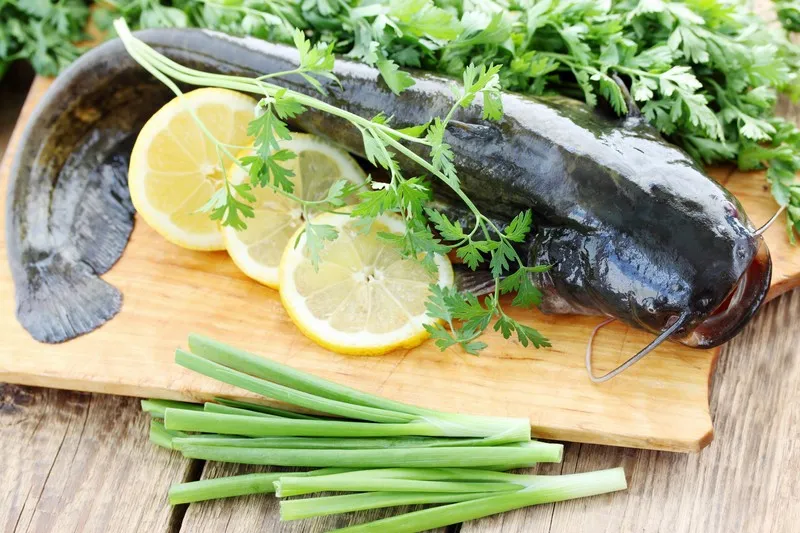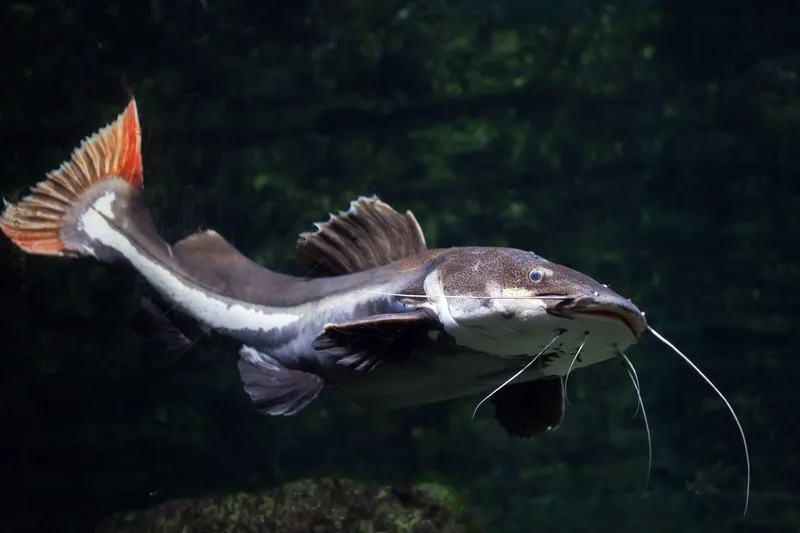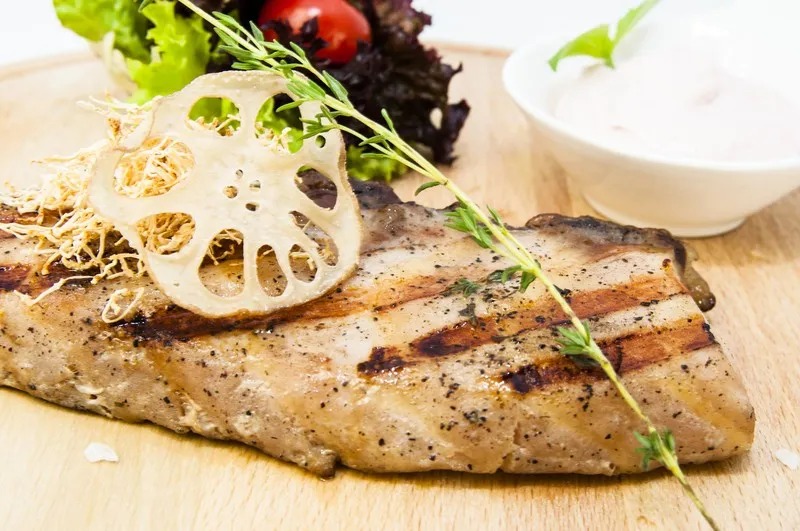Catfish has been a popular food source for ages, with various cultures incorporating it into their traditional cuisines. It is no surprise that it has found its way onto the plates of many people around the world.

Catfish can be grilled, fried, boiled, smoked or even stewed to make a delicious meal. Its versatility in preparation methods and rich flavor profile is what makes it an attractive culinary option.
However, one question that lingers in the minds of catfish enthusiasts is: What is the best catfish size to eat? Is it better to go for smaller or larger catfish? The answer to this question seems elusive as there are different arguments for both sides. Some say small catfish are tender and tastier while others argue that large ones have more meat and are easier to prepare.
After checking out this article, read The Best Catfish Rig for Bank Fishing.
Small vs Large Catfish
The big debate among catfish enthusiasts about whether small or large catfish are better suited for consumption has yet to be resolved. Those who prefer smaller fish argue that they have tender flesh and a richer flavor profile than their larger counterparts.
The argument here is that as they grow older, they become tougher and less tasty. On the other hand, those who argue in favor of large catfish claim that bigger fish have more meat on them which makes them more satisfying when cooked properly.
They insist on the fact that one can achieve more consistency when cooking larger fish compared to smaller ones which may be overcooked or undercooked. Another argument against small fish is based on economics where some assert that catching small fish requires more effort than catching large ones which means smaller catches would not be worth investing in.
Ideal Catfish Size Range
It’s important to note that there’s no single answer on what’s most ideal size of catfish to eat. It ultimately comes down to personal preference and the culinary intention of the chef. However, there are certain factors that contribute to an ideal catfish size range for consumption.
One significant factor is the age of the fish. Catfish mature at different rates depending on their species, however, generally speaking, catfish below 18 inches long are immature and still growing which means they may not have reached their flavor potential yet.
Moreover, diet largely determines the quality of fish meat in terms of flavor and texture. The type and quantity of food consumed by catfish plays a vital role in determining its taste quality. Therefore, it is necessary to ensure that catfish have a healthy diet before they are caught for human consumption.
No products found.
Regional Differences in Catfish Consumption
It’s fascinating how different regions around the world have their own preferred sizes when it comes to eating catfish. In some countries such as Vietnam and Thailand, small fish are preferred because they can be cooked whole and served as street food snacks.
In other regions like America’s south where fried or grilled catfish is a staple in many households, larger ones between 3-5 pounds are preferable because they yield more fillets which can feed entire families.
Cultural preferences also come into play when deciding what size of fish is best for consumption. For instance, some groups may consider it taboo to consume very large fish because they believe it may be spiritually harmful or indicate poor fishing practices.
A Matter of Personal Taste: Individual Preferences
It cannot be overstated that ultimately what makes the best size of catfish comes down to personal preference. Everyone has their own tastes when it comes to consuming any kind of meat, fish included – some prefer tender meat while others prefer tougher ones.
Therefore my advice would be for people to experiment with different sizes and preparation methods until you find your perfect fit. You might find that grilling a small fish brings out the best of its flavor, or that baking a large fish gives it the perfect texture you love.
Environmental Impact
Looking at the bigger picture when it comes to seafood consumption, one needs to consider the environmental impact. Overfishing has led to a decrease in catfish populations, which means that there may be fewer of them available for human consumption in the future. It’s essential that consumers become more conscious about their seafood choices and opt for sustainable options.
Most experts agree that eating smaller fish is better for sustainability as larger ones take longer to mature and reproduce. This means that it’s better to avoid taking out large breeding stock from the water bodies. Choosing what size of catfish is best depends on an individual’s preferences and culinary intentions. Factors such as age, diet, cultural preferences and regional differences also come into play. It is crucial though to consider sustainability when making your choice so that future generations can enjoy this delicacy too.
The Big Debate: Small vs. Large Catfish
Flavor: Why Bigger Isn’t Always Better
There seems to be a common misconception among some catfish enthusiasts that bigger is always better when it comes to picking the perfect fish to cook up for dinner. But when it comes down to it, the size of the catfish can greatly impact its flavor profile, and not always in a good way. Large catfish can often have a stronger, more pronounced flavor that some people find off-putting. They also tend to have tougher meat that can be harder to cook evenly and result in an unpleasant texture.
In contrast, smaller catfish are more likely to have a mild, delicate flavor that’s easier on the palate and more versatile in terms of cooking methods. Sure, large catfish might offer more meat per fish, but if you’re sacrificing taste and texture for quantity then what’s really the point?
Texture: The Battle Between Tender and Tough
Another point worth considering is texture. As mentioned earlier, larger catfish tend to have tougher meat that can be tricky to cook without turning rubbery or dry. Smaller catfish, on the other hand, are much easier to work with and provide a tender bite with each forkful.
Some people may argue that they enjoy the meaty chewiness of larger fish or that they prefer their fish with more “bite”, but ultimately it comes down personal preference. In my opinion? There’s nothing worse than sitting down for a meal only to find yourself struggling through tough bites of overcooked catfish.
No products found.
Ease of Preparation: Keeping It Simple
When it comes down to actually preparing your catch for dinner time, smaller catfish offer one key advantage over their larger counterparts: ease of preparation. Smaller fish are much simpler and faster to clean, fillet, and cook. This means that you can spend less time fussing over your fish and more time enjoying the fruits of your labor. Large catfish, on the other hand, require a bit more work to prepare properly.
Not only do they take longer to clean and fillet, but they also require more careful cooking techniques to ensure that they turn out just right.
Going Against the Grain: Why I Prefer Small Catfish
At the end of the day, there are valid arguments for both sides of this debate. However, as someone who has spent years catching and cooking catfish for my family and myself, I have to say that I come down firmly on the side of small catfish. To me, the benefits of a mild flavor profile, tender meat texture, and easy preparation far outweigh any potential advantages that larger catfish might offer.
Plus, smaller catfish are often easier to catch in larger quantities which makes them perfect for feeding a group or stocking up for later meals. When it comes to choosing the best size of catfish for eating purposes – don’t be fooled by common misconceptions. Small is beautiful in this case!
The Sweet Spot: Ideal Catfish Size Range

Introducing the Ideal Catfish Size Range
Catfish are a popular type of fish that can be found all over the world. Many people enjoy eating catfish, but there is often some debate about what size catfish are best for eating. In my opinion, there is an ideal catfish size range that should be considered when choosing catfish for consumption.
The ideal catfish size range includes fish that are between 1 and 5 pounds in weight. This range provides the perfect balance between flavor and texture. Larger catfish tend to have a tougher and less flavorful meat, while smaller catfish may not have enough meat to make it worth the effort.
Factors Contributing to the Ideal Size Range
Age and diet are two factors that contribute to the ideal catfish size range for eating purposes. Younger catfish tend to have more tender meat than older catfish, which can become tough as they age. Additionally, diet can also impact the taste and texture of the meat. Catfish that live in clean water with a healthy food source will generally taste better than those that live in polluted water or eat a poor quality diet.
This is why it’s important to consider where your fish came from before purchasing it. Another factor to consider is how you plan on cooking your catfish. Some cooking methods work better with certain sizes of fish than others. For example, larger fish may be better suited for grilling or smoking, while smaller fish may work well for frying or sautéing.
The Benefits of Choosing an Ideal Size Range
Choosing an ideal size range when it comes to eating catfish has several benefits. First and foremost, it ensures that you get the best possible flavor and texture from your fish. Additionally, choosing an ideal size range can also be beneficial for the environment. Overfishing of certain sizes of catfish can have a negative impact on the population, which can ultimately impact the ecosystem as a whole.
By choosing to only consume catfish within the ideal size range, you can help promote sustainable fishing practices and do your part to protect our natural resources. Choosing an ideal catfish size range for eating purposes is important for several reasons.
By considering factors such as age and diet, you can ensure that you get the best possible flavor and texture from your fish. Additionally, choosing an ideal size range can also be beneficial for the environment by promoting sustainable fishing practices.
So next time you’re in the market for some delicious catfish, remember to choose fish within the ideal size range – your taste buds (and Mother Nature) will thank you!
Niche Preferences: Regional Differences in Catfish Consumption

Explore how different regions have their own preferred sizes when it comes to eating catfish
When it comes to choosing the best size of catfish to eat, regional preferences play a major role. In some areas, small catfish are favored for their tenderness and mild flavor. In other regions, larger catfish are prized for their meatier texture and stronger taste.
For example, in the Southern United States, particularly in Louisiana and Mississippi, smaller catfish between 1-2 pounds are preferred for frying. The belief is that smaller fish stay moist during frying and have a more delicate flavor than larger fish. On the other hand, in states like Texas and Arkansas, larger catfish weighing over 5 pounds are often sought after for their meaty flesh that holds up well to grilling or smoking.
Local traditions or cultural preferences
Regional differences in catfish consumption can also be attributed to local traditions or cultural preferences. In Louisiana, for example, fried catfish is a staple dish often served with hushpuppies and coleslaw at family gatherings or church events.
Similarly, in West Africa where freshwater fishing is common along the Niger River delta region of Nigeria and Cameroon known as Bight of Bonny (Bight of Biafra), smoked and fried medium-sized (between 1-4 pounds) African Catfish is commonly eaten by locals. In some cultures such as those found in Southeast Asia – specifically Thailand – small whole grilled fish is often served with spicy dipping sauce as an appetizer or street food dish known as Pla Pao (ปลาเผา). Different countries have different customs related to what parts of the fish should be eaten depending on size preference; while people from some Southeast Asian countries might look for larger fish, people from other Southeast Asian countries might consider smaller fish to be more delicious.
In the American South, catfish is also often served with side dishes like grits or collard greens, which further emphasizes the regional importance of this dish. In contrast, in Japan, catfish is often enjoyed as a sushi topping or in nabemono (hot pot) dishes. Ultimately, regional differences in catfish consumption highlight the diverse ways in which this adaptable and delicious fish can be enjoyed around the world.
Cultural Fusion: Blending Regional Preferences
In some cases, regional preferences for catfish size have blended together to create unique culinary traditions. This is particularly evident in places like Maryland where it’s not uncommon to find a dish called “catfish stew” that combines smaller catfish fillets with vegetables and spices traditionally used in Creole cuisine.
Similarly, Vietnamese cuisine has incorporated both small and large catfish into dishes such as Canh Chua (sour soup) and Ca Kho To (caramelized claypot fish), respectively. Vietnamese also eat grilled whole medium-sized Catla or Pangasius Fillet wrapped in banana leaf with herbs which they call “Ca Nuong La Chuoi”. These fusion dishes not only showcase the versatility of catfish as a food source but also highlight how cultural exchange can lead to new and exciting culinary experiences.
The Future of Catfish Consumption: Sustainability Concerns
Despite its widespread popularity as a food source, there are concerns about the sustainability of catfish farming practices. Currently, most commercially farmed catfish are raised using intensive methods that can lead to environmental degradation and potential health risks for consumers. To address these concerns, some advocates have suggested promoting more sustainable aquaculture practices or encouraging consumers to choose wild-caught catfish instead of farmed varieties. Others promote stricter regulations on water pollution caused by catfish farming operations. As we continue to enjoy catfish as a delicious and versatile food source, it’s important to also consider the environmental impacts of our consumption habits and work towards more sustainable solutions for the future.
A Matter of Personal Taste: Individual Preferences
Size Matters
When it comes to catfish, size matters. Some prefer smaller catfish because they are easier to eat and have a milder flavor. Others prefer larger catfish because they have a firmer texture and more pronounced flavor. Ultimately, the best size of catfish to eat is subjective and varies from person to person.
The Preparation Factor
The way a catfish is prepared can greatly affect its taste and texture. While some people prefer fried catfish, others may enjoy it grilled or baked. The preparation method can also impact the optimal size of the fish – for example, smaller catfish may be better for frying while larger ones may work better for grilling or baking.
Experimentation is Key
To truly find your personal favorite when it comes to eating catfish, you need to experiment with different sizes and preparations. Try cooking up different sizes of fish using various preparation methods until you find what works best for you. Don’t be afraid to mix things up – try adding different spices or breading mixes to your fried catfish or experimenting with different marinades when grilling.
The Regional Influence
It’s important to note that regional differences can also play a role in individual preferences when it comes to eating catfish. For example, in some areas of the country, people may prefer smaller catfish that are breaded and fried whole, while other regions may favor larger fillets that are grilled or blackened.
Cultural Traditions
Cultural traditions can also influence individual preferences when it comes to eating catfish. In certain cultures, there may be specific ways that the fish should be prepared or specific sizes that are considered ideal for consumption. There is no one-size-fits-all answer to the question of what is the best size of catfish to eat. It ultimately comes down to personal taste and preferences, as well as other factors such as regional differences and cultural traditions. So go ahead and experiment with different sizes and preparations until you find your perfect catfish dish – whether it’s a small fried whole fish or a large grilled fillet. Happy eating!
Frequently Asked Questions
Different catfish species have varying qualities of meat, but some of the most commonly recommended for consumption are channel catfish, blue catfish, and flathead catfish due to their taste and texture.
Channel catfish is the most commonly consumed catfish species in the United States, followed by blue and flathead catfish.
Blue catfish over 20 inches long and weighing 2-3 pounds are considered good for consumption, as they have enough meat and are not too big.
The recommended weight range for eating catfish varies depending on the species, but generally, catfish weighing 1-10 pounds are ideal for consumption.
While all types of catfish are technically edible, some species are not recommended for consumption due to their tough texture, unpleasant taste, or potential toxicity.
It is generally safe to consume large flathead catfish, although there are concerns about mercury levels in larger specimens, so it is recommended to limit consumption and avoid eating large flatheads too often.